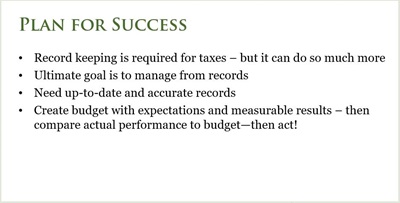January 14, 2020
Fundamentals beginning farmers need to run a successful business
By: Heather LaPierre

On December 19, 2019, Farm Credit East hosted a webinar entitled “Business Basics for Beginning Farmers.” In this webinar, Chris Laughton, Director of Knowledge Exchange, presented information on a range of financial topics of interest to beginning farmers. These topics included recordkeeping, financial statements, cash flow budgeting, financing and credit. Here’s a summary of these key topics.
The importance of recordkeeping
In the introduction, Chris talked about the three main areas of business skills — production, marketing and financial skills. It is unlikely that a producer is skilled (or has time) in every one of these areas. Chris recommended to identify your strengths and hire a partner to complement the areas where you aren’t as efficient.

In all management areas, he noted the importance of good recordkeeping and using those records to plan for success. Using the five-line income statement, he talked about the difference between fixed and variable costs, why each are important and how they behave differently. Chris concluded this section by explaining the difference between cash and accrual accounting, and how the two methods can yield different records and results.
Financial statements 101
The three main financial statements for any business are the balance sheet, income statement and cash flow statement or budget. Attendees were walked through the purpose of each statement and an example of each. In summary, the balance sheet is a “snapshot” of the financial standing of an individual or firm. This financial statement details assets, liabilities and net worth. The income statement tracks earnings and expenses over a specific period of time, typically monthly or annually. Finally, the cash flow statement or budget tracks the comings and goings of cash over time. This last statement can be extremely useful in planning ahead to make sure your business can pay its bills moving forward.
Chris spent time going through a sample cash budget spreadsheet and provided two excel resources with sample farm budgets. These examples can be found on the webinar recording page.
Credit and financing
The last section of the webinar covered credit and financing. Chris began by providing a list of the different types of financing and sources of capital that may be available to beginning farmers. Pivoting to what a lender evaluates when deciding to make a loan, Chris discussed the “Five Cs of Credit.” These five Cs – character, capacity, collateral, capital and conditions – are some of the main things that lenders consider when deciding whether to offer credit. The five areas were detailed in the presentation.
From his years of business experience, Chris covered a few tips to avoid when navigating business decisions. This included a list of “lender turn-offs” – poor records, bad credit, lack of commitment, etc. – that may signal a potential borrower needs work on one or more areas of the five Cs.
Overall, this webinar was designed to offer some introductory information that a new or beginning entrepreneur in agriculture, commercial fishing or the forest products industry should know before approaching a lender or investor. For a recording and presentation materials from this webinar, visit FarmCreditEast.com/webinars.




